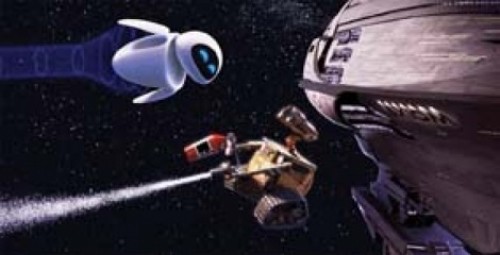Cinema | Aye, Robot: In the lyrical WALL-E, a machine teaches humanity how to rediscover beauty
By Scott Renshaw @scottrenshawBecause writer/director Andrew Stanton and his Pixar cohorts are such extraordinary storytellers, there has been plenty of metaphorical content strewn throughout the computer-animation pioneer’s consistently delightful features: a critique of radical egalitarianism in The Incredibles; Cars’ paean to the roadkill left on the superhighway to “progress.” In WALL-E, Stanton recognizes that his little robot has developed a soul because of what he does that’s not part of his mundane routine. Being human, he reminds us, is about the ability to recognize beauty—the kind of beauty you find in a work of art like this breathtaking little miracle of a movie.
One could get hung up, I suppose, on the potentially political content of its premise. WALL-E presents its 28th-century Earth as a dust-blasted cityscape, the result of a consumer culture encouraged by the omnipresent Buy-N-Large corporation (its president, played by Fred Willard, appears to have become the country’s ever-grinning de facto ruler). When another robot called EVE (Elissa Knight) arrives on a mission to find any sign of life, WALL-E falls in love at first sight and follows her back to the massive spacecraft that has become the home-in-exile of surviving humanity. There, people have evolved into obese slugs in chaise-lounge hoverchairs, cruising around not only apparently oblivious to the fact that they’ve ruined one world but still blindly self-obsessed. When the ship’s captain (Curb Your Enthusiasm’s Jeff Garlin) begins engaging with the history of a planet he barely understands, he finally demonstrates a humanity that previously had seemed recognizable only in the robots.
Part of WALL-E’s genius is that Stanton builds to this idea so patiently. For approximately the first 45 minutes of the film, the story emerges with almost no spoken dialogue, dependent on visual storytelling and the electronic blips of sound designer Ben Burtt—who also created R2-D2’s “language” 30 years ago—for WALL-E’s quirky personality. And while WALL-E gets a cute little cockroach as a pet—well, cute for a cockroach, anyway—the film doesn’t aim at the attention span suggested by its G-rating. This is no passive viewing experience; it practically demands engagement.
Even once the action moves to the expatriate humans’ Battlestar Galactica-cum-Love Boat starship Axiom and human voices are heard, WALL-E remains a marvel. A tiny cleaning robot called MO obsessively scrubs behind the filthy tread marks left behind by WALL-E’s seven centuries-worth of caked-on muck; a collection of malfunctioning robots runs free on the ship like mechanical refugees from One Flew Over the Cuckoo’s Nest following WALL-E as their McMurphy. And in a sequence of almost heartbreaking poetry, WALL-E and EVE both find themselves outside the Axiom, the sleeker EVE jetting along gracefully while WALL-E propels himself with a fire extinguisher. The moment plays like a transcendent first date—Beauty and the Beast’s ballroom dance re-imagined as a waltz of two vibrant beings through the void of space.
It seems almost absurd in the presence of such lyrical filmmaking to draw attention to Pixar’s ongoing pushing of the computer-animation envelope, except that those advances become part of the storytelling. As impressive as it may be to watch the flicker of a flame grow ever more realistic, it’s even more wonderful when the reflection of that flickering flame in WALL-E’s eyes represents the spark of love. The details in this universe matter, because this universe itself comes to matter. WALL-E holds out a hope that we can find the best in ourselves, even if sometimes, it takes a technological marvel—like the work of Pixar—to remind us of how much joy we can discover if we’re willing to stop shoveling garbage long enough to fall in love.
WALL-E
Voices of Ben Burtt, Elissa Knight, Jeff Garlin
Rated G
More by Scott Renshaw
-
Film Reviews: New Releases for April 19
The Ministry of Ungentlemanly Warfare, Abigail, The Beast, Hard Miles, Sasquatch Sunset and more
- Apr 19, 2024
-
Faces of Salt Lake County book and portrait reception
Images and personal stories in a new book reveal local demographic diversity
- Apr 17, 2024
-
Feature film review: THE BEAST
A filmmaker's compelling ideas get a bit tangled in references to his creative influences.
- Apr 17, 2024
- More »
Latest in Film Reviews
Readers also liked…
-
Power Plays
Two satirical comedies explore manipulations and self-delusions by those with power.
- Aug 31, 2022





